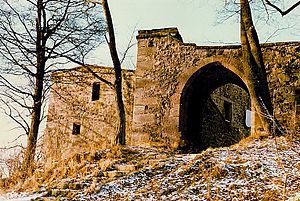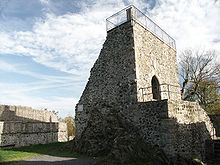Hauneck Castle
| Hauneck Castle | ||
|---|---|---|
|
Entrance to the Hauneck castle ruins on the Stoppelsberg (1980) |
||
| Creation time : | around 1300 to 1397 (1402/03) | |
| Castle type : | Höhenburg, summit location | |
| Conservation status: | ruin | |
| Construction: | Corner cuboid, humpback cuboid | |
| Place: | Haunetal -Oberstoppel | |
| Geographical location | 50 ° 45 '6 " N , 9 ° 42' 4" E | |
| Height: | 524 m above sea level NHN | |
|
|
||
The Hauneck castle ruins are within the boundaries of Oberstoppel , a district of the Haunetal municipality in the Hersfeld-Rotenburg district in Hesse .
location
The ruin of the summit castle lies on the summit of the 524 m high stubble mountain in the Kuppenrhön , the remainder of a volcanic vent that arose in the Miocene . The keep of Hauneck Castle is founded on hexagonal basalt columns that were created when the lava cooled; they appear at the base of the keep.
investment
The castle was built from basalt stone and has an approximately square basic shape. Some of the gate and window lintels, corner and humpback blocks are made of white sandstone. They come from the Lange Steine natural monument . All buildings can be assigned to the new building from the 15th century. Only the keep still comes from the first known castle from the 14th century.
The approximately 1.5 meter thick curtain wall encompasses the entire summit of the stubble mountain. The walls of the buildings are still up to 15 meters high. The gate hall with the double gate is located on the southeast side of the facility. All that remains of the building above the gate are the outer walls, which are a little higher than the arches. The inner door hinges are still preserved.
Via the southern corner of the castle, the Palas with a Gothic gate connects to the southwest . Judging by the remains of the outer wall, this building had at least two floors. It was about 17.5 meters long and 3.5 meters wide. There are some loopholes and ceiling support stones on the ground floor. In the northwest, next to the stairs to the kitchen wing, is the entrance to the basement with a barrel vault . It was a storage cellar, from which one also had access to the cistern , which was located in the courtyard next to the kitchen wing. Between this basement entrance and the stairs to the kitchen wing was the central fireplace that led to a tiled stove on the second floor. The Dürnitz was located on the second floor and was accessible via an external staircase right next to the gate hall.
To the northwest the was Palas the kitchen area cultivated. There is also a Gothic gate to the kitchen from the courtyard. Here you can still see originals of the hearth base, the pouring stone and the paved floor. Furthermore, you can still see the column foundation of the cooking chimney, remains of the chimney duct and the beginning of a narrow spiral staircase that led from the kitchen to Dürnitz. From the kitchen wing, the curtain wall leads back to the gate hall , with the lower battlement still partially preserved . No further building remains can be seen here. However, it can be assumed that there were still wooden buildings (e.g. horse stables) along this wall.
In the middle of the courtyard are the remains of the rectangular keep. From there you have a panoramic view of the Kuppenrhön , the Seulingswald and the Knüll . There is a trigonometric point on the keep .
history
The castle was probably built in the 14th century by the Knights von Haune . Their ancestral castle was about 3 km away in Burghaun , in the valley of the Haune . According to the sources, it is no longer possible to determine which of the two castles was built first. Since the name of the mountain was not lost through the castle name, it can be assumed that the first castle complex did not exist on the mountain until the 14th century. The castle was probably built to protect the Talburg in Burghaun. In addition, the lords of the castle were able to control the old Antsanvia street from here , which led not far through the Hessian skittles and the Kuppenrhön.
The castle was first mentioned in writing in 1397 (possibly not until 1402 or 1403). At this time, the Knights von Haune, together with other Buchischen knights, made an incursion into Lower Hesse . But they were defeated by Landgrave Hermann II of Hesse near Homberg . He chased the survivors to the Fulda area and captured the castle, which was partially destroyed.
The castle was also strategically interesting for the landgrave. It was on the border with the Fulda area, on the old road from Würzburg to Fulda and close to the Antsanvia. So the castle was restored and the Landgrave forced Heinrich von Haune in 1409 to sell the castle to him. With this purchase, the villages of Ober- and Unterstoppel also changed hands in Hesse. Hauneck became the Hessian court and official seat.
When the Landgraviate of Hesse was divided after the death of Ludwig I, Hauneck came to Hesse-Marburg , but the Hessian Fratricidal War that followed in 1469 led to the castle being destroyed for the second time. Ludwig II of Hessen-Kassel tried to gain influence with the important knightly family of the von Buchenau . For this purpose his marshal, Simon von Wallenstein , demanded entry into this clan. This led to a dispute within the von Buchenau family between the proponent of this membership, Simon von Buchenau, and the opponents of the matter, Bosso and Georg von Buchenau. In 1469 Heinrich III tried . from Hessen-Marburg with the support of Fulda troops to drive out Simon von Buchenau. He moved with 4,000 men to the siege of the castle in Buchenau (previous building of the castle). Thereupon Ludwig II came to the aid of the distressed Simon with a relief army. Heinrich's siege troops fled when the relief army advanced. Simon then took revenge on Henry III by destroying Hauneck Castle.
It was only between 1482 and 1490 that Wilhelm III. rebuild the castle by the fortress builder Hans Jakob von Ettlingen . It became the seat of a bailiff appointed by the House of Hessen-Marburg (later by Hessen-Kassel ). The first bailiff was Hans Jakob von Ettlingen. In 1499 Engelhard von Buchenau called himself “Amtmann zu Hauneck”. The official seat was moved to Holzheim (today a district of Haunetal ) in 1560 .
Due to the renewed division of Hessian inheritance after the death of Landgrave Philipp the Magnanimous , the castle fell to Ludwig III in 1567 . from Hessen-Marburg . In 1572 another Jakob Schröder was mentioned as "Voigt uff Hauneck". From this time on the castle was no longer mentioned in any documents. It can therefore be assumed that it was already uninhabited in the last quarter of the 16th century and has since fallen into disrepair. It can also be assumed that it suffered considerable damage in the Thirty Years' War .
The castle ruins had to be closed on August 1, 1981 because of the risk of collapse. The now secured ruin was reopened on May 20, 1982 with an accessible keep.
The Hauneck Office
In 1585 the villages of Oberstoppel and Unterstoppel belonged to Hauneck (as in 1409 they belonged to the court) and now also Kruspis, Rhina and Rothenkirchen. Between 1680 and 1686 the villages of Holzheim and Starklos, bought by the von Romrod family, were added, as well as the Heisenstein farm (secret council files, domains). After 1722, the Schildschlag office to the east with its four locations Eitra, Fischbach, Sieglos and Wippershain was affiliated.
literature
- Rudolf Knappe: Medieval castles in Hessen. 800 castles, castle ruins and fortifications. 3. Edition. Wartberg-Verlag, Gudensberg-Gleichen 2000, ISBN 3-86134-228-6 , p. 194.
- Georg Landau : The Hessian knight castles and their owners . Vol. 1, Sendet Reprints Verlag, Vaduz / Liechtenstein 1990 (unchanged reprint of the 1832 edition), pp. 123–128.
- Rolf Müller (Ed.): Palaces, castles, old walls. Published by the Hessendienst der Staatskanzlei, Wiesbaden 1990, ISBN 3-89214-017-0 , p. 167f.
Individual evidence
- ^ Schildschlag, Hersfeld-Rotenburg district. Historical local lexicon for Hesse (as of February 17, 2014). In: Landesgeschichtliches Informationssystem Hessen (LAGIS). Hessian State Office for Historical Cultural Studies (HLGL), accessed on February 1, 2016 .
Web links
- Hauneck Castle on the burgenwelt.org website
- Virtual 3D reconstruction of Hauneck Castle at ekwdesign and bekwadrat medienproduktion, Bad Hersfeld
- Hauneck Castle, Hersfeld-Rotenburg district. Historical local dictionary for Hesse (as of November 16, 2015). In: Landesgeschichtliches Informationssystem Hessen (LAGIS). Hessian State Office for Historical Cultural Studies (HLGL), accessed on February 1, 2016 .





